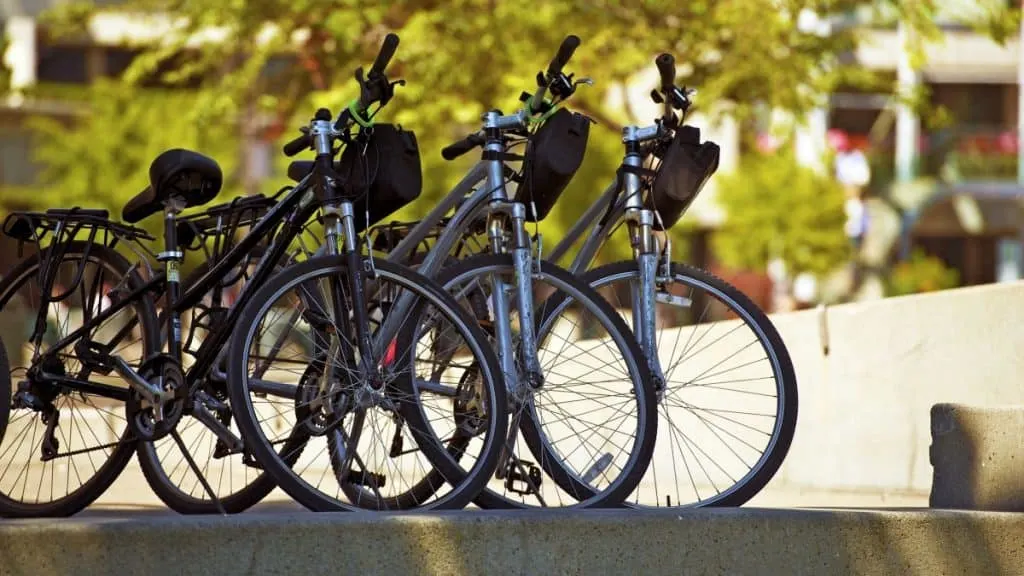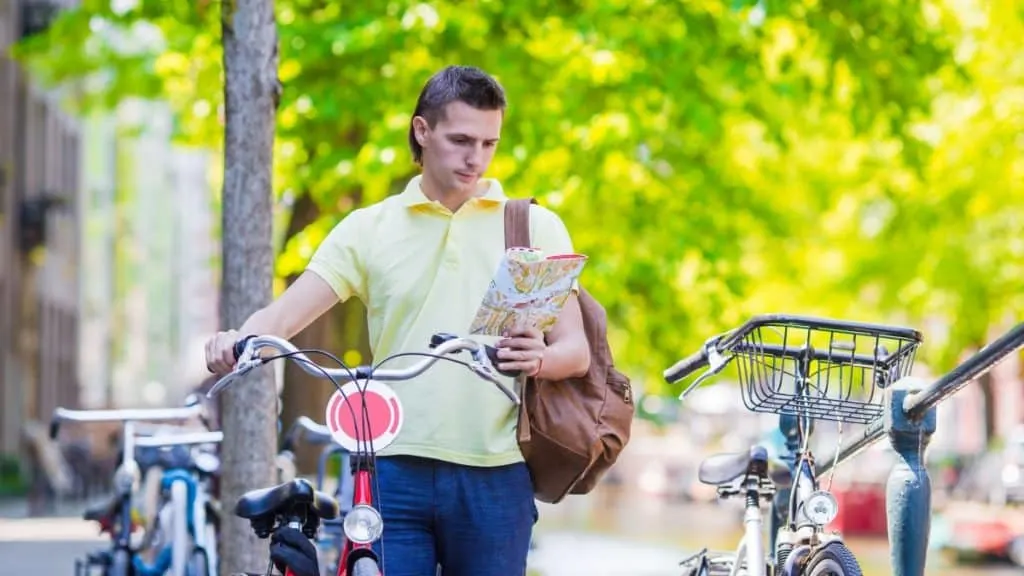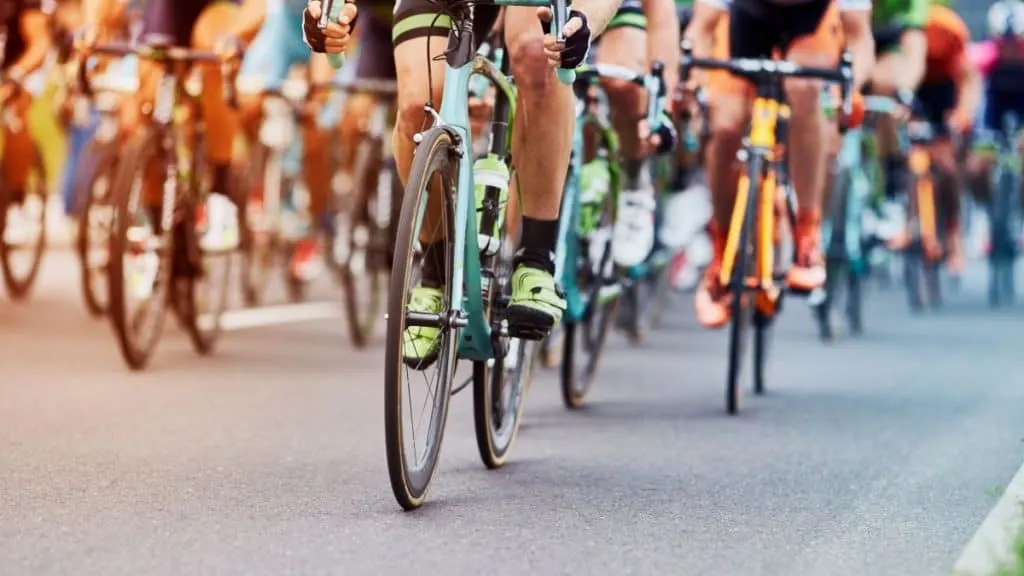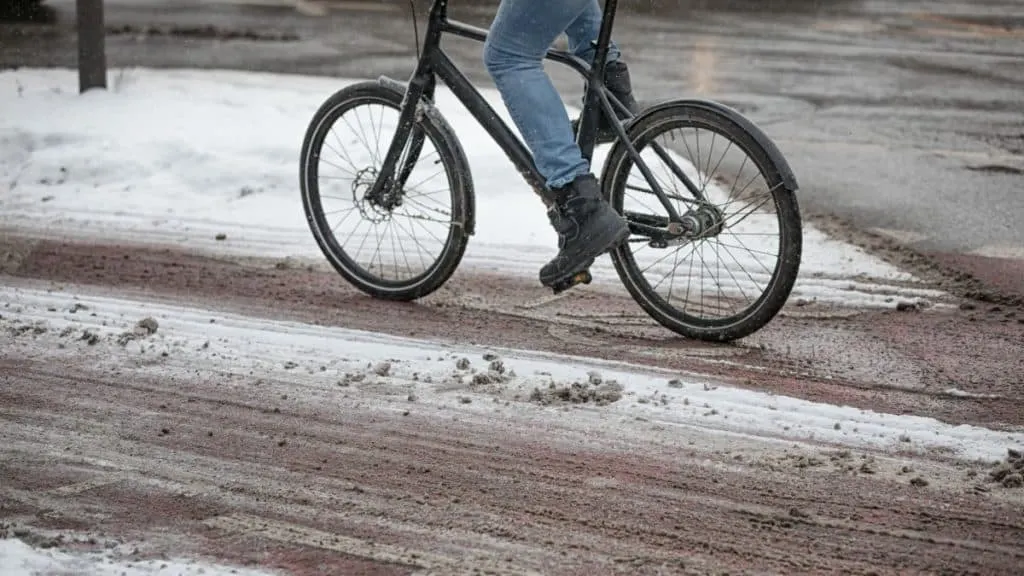
I originally got into cycling as an adult through someone promoting cycling in my city via a weekly group, and I’m forever grateful because I’m still cycling today. If you’re also an avid cyclist and bike-lover who wants to promote cycling in your city, there are a number of ways to get started.
You can promote cycling in your city by:
- starting a weekly cycling group
- commuting to work by bike
- mapping bike paths
- getting involved in city community planning measures
- offering cycle confidence lessons
- Promoting cycling events
- getting children involved in cycling
Let’s talk in more detail about some ways that you can start promoting cycling in your city, and how you can spark a change in your city to make it a more cycle friendly place that you and your community can benefit from.
The Effect of Promoting Cycling in Your City
Promoting cycling in your city can be a rewarding experience for yourself, the people who get involved, and the city itself. It can even have a knock on affect further afield.
The effect that one persons passion can have on a city can be phenomenal. And to give you a real life example, just take a look at what happened to MY community…
I was persuaded by a couple of friends go to a weekly cycling group together. We turned up to the group with some rusty old bikes that we hadn’t used in years and decided to just go for it.
It was supposed to be a one off that we did just for fun, which we would never have had the courage to do if we hadn’t had a ‘group’ there for moral support and safety.
We were surprised to learn that the group had only 2 people, who had been doing these rides for about a month on their own. But once we had finished our ride with them we were absolutely hooked!
We told other friends, who told their friends and before you know it, we had a large group of weekly cyclists getting the attention of our local community, AND the local city authorities!
Fast forward 3 years ahead, we now have groups running ACROSS THE WHOLE COUNTRY, have won awards for our contribution to society, and have influence over the infrastructure that is built in cities all over the country to make sure it is as cycle friendly as possible.
We essentially started a cycling revolution from very humble beginnings and have ended up having a huge positive impact on so many, from the people who join our cycle rides, to the wider community having a safer, cleaner environment to live in.
The point of this story is, YOU can also have this positive impact on your community. And this article will discuss some simple and creative ways that you can get started. These ideas can be used individually, or in combination to make a greater impact…
#1: Start a Weekly Biking Group
So this was obviously going to be my first choice, because it was the one that influenced me to start cycling, and literally changed the course of my life!
Open this group up to cyclists of all levels and ages, including parents with young children. This way, more individuals are encouraged to sign up.
People tend to feel more confident about starting to cycle in a group rather than on their own because of the support and confidence it brings, from being around other people who are also cycling.
Then, create a communication hub either online or at a local coffee shop where you can post and share information about each upcoming weekly ride and its route.
After a few successful group rides, take suggestions from members for new ride locations or new routes. Those who enjoy the weekly events will likely invite their friends, and soon you will have a large group of cyclers biking across your city.
QUICK TIP: Some cycle groups split the route in half with a coffee break in between. Consider a route to a local coffee place where your group can socialize and get to know each other, and then take a different route back. This will encourage the group to get to know each other, which will help the group to continue growing!
#2: Commute to Work by Bicycle
Commuting to work by bicycle is a great way to encourage others in your city to start biking. Many employers already offer perks and benefits to employees that bike instead of drive. These include prizes, honorable mentions, and even longer lunches, depending on the company.
Invite your co-workers and neighbors to bike to work with you, and remind them that this will not only be an excellent and healthy start to their day, but it will also save them money on parking. Talk to your employer to find out more about the perks of daily commuting to your job.
#3: Map Your City’s Bike Paths

When you decide to promote safely biking throughout your city, it is important to know which path is the safest to use on a bicycle. The best way to find this information is to map your city’s bike paths.
Once you are comfortable with the many different bike paths available within your city, you can share this information with others through blogs, websites, or community public service boards.
This way, those without access to bike path map information will feel more comfortable attempting to traverse the city by bike. To map your city’s bike paths, you must take the following steps:
Step 1: Decide which part of town you are trying to get to
Step 2: Utilize Google maps or another map engine by clicking the ‘biking directions’ option
Step 3: Record the shortest way to your destination that uses bike paths for the entire trip
Step 4: Find a return route using the same method.
Step 5: Take your bike out on these paths to double-check that the directions are safe, accurate, and accessible.
Step 6: Repeat this process for multiple main points around the city, creating a comprehensive map of bike paths that you can share with others.
QUICK TIP: In addition to recording the shortest route, you could also record the most scenic route, or the route with the least amount of traffic to help cyclists who are shy to cycle in busy built up areas.
#3: Start a Bicycle Lending Program
Across the world, large metropolitan cities have begun offering bike-lending opportunities to their citizens and residents. Some cities even offer special discounts and perks, like a free hour-long rental, to encourage people to bike instead of drive.
This is especially useful for those who do not own or cannot afford to own bicycles. It’s actually the way I started to bike regularly, because a bike can be a big investment if you’re not sure how much you’re going to use it yet.
If your city does not already offer a bicycle lending program, consider starting one of your own. You can begin a bicycle lending program by:
- Asking your friends and neighbors to donate their unused or ill-fitting bicycles for the program
- Applying for grants to pay for the purchase of multiple bikes
- Collaborating with a local bike shop in exchange for marketing
- Purchasing old bikes and fixing them up yourself to lend them out privately
- Meeting with city officials to discuss public funding of such a program
#4: Become Involved in Community Planning
Community planning is one of the most important aspects of creating a city that is conducive to cycling. Decisions on bike lanes, bike-only pathways, and traffic signs are often made at community planning meetings.
To encourage more cycling in your city, consider becoming more involved in its community planning. Take a stance on making your city more bike-friendly to encourage more people to bike throughout the community. Become more involved by:
- Attending community planning meetings and hearings
- Becoming active in your neighborhood association’s bike safety program
- Becoming aware of cycle planning principles such as welfare, practicality, and continuity of programming and roadways
- Holding a fundraiser for your local city bicycle program
- Joining regional and local transportation planning committees
- Starting a community bike safety neighborhood watch
#5: Get the Children Involved
One of the best ways to promote cycling in your city is to get the children involved. Teaching younger generations how to use biking in their city will be a great skill for them to have and will encourage more people to start cycling in the future.
If children grow up cycling with their friends and parents, they are more likely to continue cycling as adults. You can get your city’s children involved in cycling by:
- Cycling with your own kids and offering to take their friends along
- Offer to start a donation-based cycling safety program for local children and their parents in your city
- Reach out to local elementary and middle schools about volunteering for their cycling programs or physical education courses
- Start a parent-child cycling group that gathers weekly and cycles to the park or other family-friendly locations
#6: Offer Confidence Boosting Lessons at a Local Park
One very common obstruction that people have to getting on a bicycle, is that the last time they rode one was when they were a child. Offering free classes ‘practice classes’ in a local park is a great way to help people overcome the fear and become more confident riding a bike in a safe environment before taking to the streets.
You can advertise through local social media or ask friends & family to spread the word. Even if only one or two people turn up at the beginning, it can have a knock on affect on others joining in once word gets around!
QUICK TIP: Offering road safety tips and road safety practice sessions in a safe park area is also a great way to help increase confidence and increase safety awareness among newbie bikers.
#7: Promote Cycle-Promoting Events Across the World

Many amazing events across the world encourage cycling for both professional cyclists and hobbyists alike. Promoting these in your local community will help bring attention to cycling in general. It’s a great way to get the community involved indirectly, to help foster a love for cycling, or even better, to start attending these events.
The events are often sanctioned by the city in which they are held or run by non-profit organizations. From bike races to environmental protests, these famous cycling events include:
- Pedalpalooza: Pedalpalooza is a dispersed annual bike festival located in Portland, Oregon, in which hundreds of people participate in different themed rides across the city. Each ride takes place on a different night throughout the multiple-week long festival, encouraging participants of all abilities and ages. Themes range anywhere from ‘flashing lights’ to ‘The Beatles’ and more.
- The Solstice Cyclists: The Solstice Cyclists is a clothing-optional event that happens in Seattle, Washington, to celebrate the coming of the summer solstice. This event acts as a parade in which all are welcome to dress up, dress down, and enjoy the summer weather by cycling across the city.
- Tour de France: Located across France, the Tour de France is one of the most famous cycling races in the world. First occurring on July 1st, 1903, this race occurs yearly and over the course of 23 days.
- World Naked Bike Ride: The World Naked Bike ride is a bike ride that happens in Portland, Seattle, Los Angeles, New York, and other cities during the summertime. Originally created as a protest against fossil fuels and the causes for global warming, participants ride nude, donning costumes or in body paint. Riders show up in the thousands and have a huge bicycle riding party across their city, often beginning and ending at a local park.
#8: Promote the Benefits of Riding a Bicycle
When promoting cycling, you also have the chance to share the many pleasing benefits that come along with taking up bicycle riding.
Regardless of whether you choose to speed bike in preparation for a cycling race or take a leisurely ride on your seated town bike, all forms of bicycling have benefits that increase both individual well-being and the health of the planet.
Promoting these benefits will help encourage more people to take up bicycling. Let’s take a brief look at just a few of them…
The Health Benefits of Cycling
The health benefits of cycling are not only physical but mental as well. In a brain study done by scientists in the Netherlands, it was found that when taking part in an embedded muscle-memory based skill like bicycling, the motor function needed to enact the skill impacts brain matter.
In turn, white fibrous brain matter increases, making our memories stronger. When studying those who did not bike, the white brain matter remained the same and did not increase.
While this study was conducted specifically on patients diagnosed with Schizophrenia, it is considered that the same benefits of cycling will extend to a neurotypical brain as well.
Though cycling alone should not be used to treat or heal any ailments without doctor supervision, other main health benefits of cycling can include:
- A higher lung capacity
- A lowering in stress levels
- Increased calcium production for stronger bones
- Increased cardiovascular stamina
- Lower blood pressure
- Stronger bicep arm muscles, resulting in stabilized shoulder and elbow joints
- Stronger spinal muscles, resulting in better posture
- Stronger quadricep and hamstring muscles, resulting in more supported knee joints
- Weight loss and regulation
- And more
For more information on the benefits of cycling, check out my article “11 Benefits to City Cycling”
The Environmental Benefits of Cycling
Along with great personal health benefits, cycling also results in excellent benefits for the earth’s health and the environment.
According to the Adventure Cycling Association, making your bicycle excursions more common and driving anywhere to one mile or three miles less each day can have a big impact on lowering emissions and limiting fuel consumption.
This study, taken from Thomas Gotschi, Ph.D. and Kevin Mills, J.D.’s Active Transportation for America, The Case for Federal Investment in Bicycling and Walking in 2008, suggests that this increase in biking could save millions of tons of CO2 emissions from being released as well as up to a billion fuel gallons. Other environmental benefits of cycling are:
- Less need for parking structures, which often sit empty on nights and weekends
- Less oil needed on a daily basis, therefore creating less need for ecosystem-damaging oil drilling
- Less toxic greenhouse gasses being released into the atmosphere
- Less traffic on the roads, especially during rush hour
- The freeing up of large green spaces otherwise cut down to build roads
- The reduction of air pollution
- And more
For further details on how cycling can benefit your city, check out my article “8 Ways Cycling Helps your City & You”
The Financial Benefits of Cycling

In addition to health and environmental benefits, cycling comes with its own set of financial benefits as well. When choosing to go by bicycle instead of by car, you are effectively opting to save money in the long run. Some of the best financial benefits of cycling rather than driving or taking public transportation include:
- Saving on transportation fares: Riding your bike instead of taking the bus or hailing a taxi means saving those dollars that would otherwise be spent on a two-way ride.
- The availability of less expensive insurance: Many car insurance companies now offer insurance plans based on the mileage you drive. If you opt for biking rather than driving throughout the year, your annual mileage will decrease, and you may become eligible for a less expensive car insurance option.
- Using less fuel: Fossil fuels, known as gas or oil, are used to power our vehicles. When we drive less, we do not find ourselves needing to fill up on and pay for fuel as often, therefore saving money.
- Local bonuses and benefits: Many restaurants, movie theaters, and shops in your area might have programs that reward those who travel by bike. Some businesses offer free beverages, discounts, or coupons to those who choose to cycle, while others create stamp-based reward programs. Offices, too, have adopted this method of rewarding their employees with prizes and honorable mentions. Contact yours to find out more.
For more detail on exactly how much you can save when switching to a bike for commuting to work, check out my article here.
Some Things to Bear in Mind…
Promoting cycling in your city is a very rewarding experience, especially when you can see the fruits of your labor after putting in all the effort! It will take some time for this to happen, but patience and consistency is key here.
Before embarking on the journey of promoting cycling in your city, here are a couple of general things to bear in mind when it comes to cycling…
#1: Find the Best Bicycle for You
If you plan on starting to bike in your city, you must first be fitted with a quality bicycle. A properly fitting bicycle will ensure that you do not injure your knees, elbows, or spine. It will also ensure bodily comfort for longer periods of riding.
It is also important to pick the bicycle-style that best fits your needs, whether they are commuting to and from work every day or simply occasionally taking a leisurely ride to the park. When picking your bicycle, make sure that you:
- Find the right size. Ask a professional at your local bike shop about how to fit your bike to your body size.
- Get the speed option that is necessary for you. Some bicycles come with different speed options depending on their use. Decide how many speeds you would like your bike to have.
- Make sure to pick the right accessories. Accessories such as bells, lights, decorations, cats, and extra-padded seats are all available to add to your bicycle for optimum personalization.
- Pick the best style for your needs. Know what you will be using your bicycle for and choose one based on your most pressing needs, such as biking with kids, racing, or commuting to work.
NOTE: I have a detailed guide on choosing the best bike for your needs in my article here. It’ll help make the right choice if you are thinking of investing in a bike for yourself or a family member.
#2: Be Prepared for Any Weather
When preparing to promote cycling as a travel method within your city, you must be able to help riders be prepared to get caught in any type of weather. While cycling in the rain and snow can be a hassle, it doesn’t necessarily need to be unpleasant.
If you are equipped with the proper protective clothing and a weatherized bike, you will be all set to go on a safe and warm bicycle ride, no matter the weather conditions.
TIP: Check out my Recommended Gear section for information on choosing the right cycling gear for your needs.
Weatherizing Your Bike

Weatherizing your bicycle is an important part of staying safe in most weather. When your bike is poorly equipped for rain, snow, or fog, it is likely to rust, break, or cause an accident. You can keep your bike winter-weather ready by doing the following:
- Add fenders for water protection. Fenders stop water from splashing up behind your bicycle and drenching your legs, pants, and saddlebags. They effectively keep you dry.
- Check up on your chain grease. Your chain grease is what keeps your bike parts moving and lubricated. It keeps your metal parts safe from erosion and rust, especially in wet weather.
- Get a raincoat for your bike seat. A raincoat for your bike seat will keep it from getting water damage. It will also act as a surface that can be removed or wiped off before getting on your wet bike, thereby keeping your pants dry.
- Get bright safety lights for ultimate visibility. Bright lights keep you visible to other bikers and cars on dark, rainy, and foggy days.
- Install special tires for snow. If you plan on biking through a snowy city, it is important to have tires that can handle the snow without getting stuck in it. Switching to special large snow tires will help you ride atop the snow instead of getting trapped in it.
- Never leave your bike outdoors. When you get to your destination, make sure there is an overhead covering or indoor location to store your bike. Leaving your bicycle outdoors can leave it susceptible to rust and damage.
- Purchase waterproof saddlebags. Waterproof saddlebags will help keep your belongings dry while biking in the rain. They rest on the back of your bicycle and often have sealable zips and ties to keep them secure.
The Proper Winter Biking Gear
In order to keep yourself warm, dry, and comfortable when biking in your city during inclement weather, you should wear the following:
- A rain jacket. A rain jacket will keep your clothes dryer and therefore warmer.
- A slim face covering. A slim and warm face covering will fit well under your helmet and protect your mouth and nose from cold winter winds.
- Gloves. Flexible fabric gloves will protect your fingers from becoming numb in cold temperatures or winds.
- Rain goggles. Rain goggles can help keep your vision clear on very rainy days.
- Rain pants. Rain pants will act similarly to a rain jacket, keeping your clothes underneath completely dry.
- Waterproof shoes. Waterproof shoes or shoes with traction will keep your feet dry and from slipping off the bike pedals while cycling.
The Joys of Traveling by Bicycle
Traveling by bicycle is one of the most health-conscious and earth-conscious ways to traverse your city. Encouraging your family, friends, and neighbors to bike is a great first step in leading the way for others.
Whether you start a bicycle lending program, join a planning committee, or simply start bike commuting to work with others, promoting cycling in your city is beneficial for people of all ages, and can help bring your community together in fun and exciting ways.
